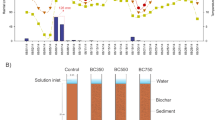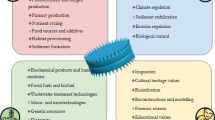Abstract
Biodetritus that formed over a 7-month period in microcosms with Viviparus viviparus, Unio pictorum, and Ceratophyllum demersum contained a number of elements. This is the first study to determine concentrations of some elements in biodetritus. Neutron activation analysis showed that the elements’ concentrations decrease in the following order: Ca > Zn > Ba > Br > Ce > Se > Nd > La > U > Hf > Sb > Th > Sm > S > Cs > Au. The data obtained contribute to understanding of the polyfunctional role of aquatic organisms in aquatic ecosystems.
Similar content being viewed by others
References
V. I. Vernadsky, Biosphere (Noosfera Publishing House, Moscow, 2001) [in Russian].
V. I. Vernadsky, Chemical Composition of the Earth’s Biosphere and its Environment (Nauka, Moscow, 1965) [in Russian].
G. V. Dobrovol’skii, “For the 80th Anniversary of Vernadsky’s’ Biosphere’ Publication. Development of Several Important Sections of the Biosphere Teaching,” Ecologic Chemistry 16(3), 135 (2007).
G. V. Dobrovol’skii, “On Development of Some Concepts of the Biosphere Teaching,” Water: Technology and Ecology, No. 1, 63 (2007).
V. N. Bashkin and N. S. Kasimov, Biogeochemistry (Nauchnyi Mir, Moscow, 2004) [in Russian].
A. I. Perel’man and N. S. Kasimov, Landscape Geochemistry (Astreya, Moscow, 2000) [in Russian].
A. P. Kapitsa, “Formulation of Fundamental Principles for Foundation of the Theory of the Apparatus of the Biosphere,” Environment Ecology and Safety of Life Activity 1(37), 68 (2007).
G. A. Leonova, V. A. Bobrov, V. P. Shevchenko, and A. A. Prudkovskii, “Comparative Analysis of Element Composition of the Seston and Sediments of the White Sea,” Dokl. Akad. Nauk 406(4), 516 (2006).
E. Grahn, S. Karlsson, and A. D Düker, “Sediment Reference Concentrations of Seldom Monitored Elements (Ag, Be, In, Ga, Sb, Tl) in Four Swedish Boreal Lakes-Comparison with Commonly Monitored Elements,” Sci. Total Environ. 367(2–3), 778 (2006).
V. K. Singh, K. P. Singh, and D. Mohan, “Status of Heavy Metals in Water and Bed Sediments of River Gomti—a Tributary of the Ganga River, India,” Environ. Monit. Assess. 105(1–3), 43 (2005).
G. A. Leonova, G. N. Anoshin, V. A. Bychinskii, B. L. Shcherbov, and V. D. Strakhovenko, “Landscape-Geochemical Patterns of Distribution of Heavy Metals in Biota and Bottom Sediments of the Altai Lakes,” Geologiya i Geofizika 43(12), 1080 (2002).
G. A. Leonova, “Biogeochemical Indicators of Aquatic Ecosystem Pollution by Heavy Metals,” Water Resources 31(2), 215 (2004).
G. A. Leonova, G. N. Anoshin, and V. A. Bychinskii, “Biogeochemical Problems of Anthropogenic Chemical Transformation of Water Ecosystems,” Geokhimiya, No. 2, 182 (2005).
S. A. Ostroumov, “Polyfunctional Role of Biodiversity in Processes Leading to Water Purification: Current Conceptualizations and Concluding Remarks,” Hydrobiologia 469(1–3), 203 (2002).
S. A. Ostroumov and M. P. Kolesnikov, “Mollusk Pellets in Biogeochemical Flows of C, N, P, Si, and Al,” Dokl. Akad. Nauk 379(3), 426 (2001).
S. A. Ostroumov and M. P. Kolesnikov, “Mollusks in Biogeochemical Flows of C, N, P, Si, and Al and Water Self-Purification: the Influence of Surfactants,” Vestnik MGU, Seriya 16, Biol., No. 1, 15 (2003).
G. M. Kolesov, “Determination of Microelements: Neutron Activation Analysis in Geochemistry and Cosmochemistry,” J. Anal. Chem. 49(1), 50 (1994).
S. A. Ostroumov, G. M. Kolesov, and D. Yu. Sapozhnikov, “On Hydrobiologic Monitoring Issues: Studies of Element Content in Unio Mollusks by Neutron Activation Analysis,” Doklady MOIP: Problemy Ekologii i Gidrobiologii (Maks-Press, Moscow, 2008), pp. 47–53.
S. A. Ostroumov, “Suspension-Feeders as Factors Influencing Water Quality in Aquatic Ecosystems,” in The Comparative Roles of Suspension-Feeders in Ecosystems: Proceedings of the NATO Advanced Research Workshop on The Comparative Roles of Suspension-Feeders in Ecosystems, Nida, Lithuania, October 2003, Ed. by R. F. Dame and S. Olenin (Springer, Dordrecht, 2005), pp. 147–164.
S. A. Ostroumov, “Some Aspects of Water Filtering Activity of Filter-Feeders,” Hydrobiologia 542(1), 275 (2005).
S. A. Ostroumov and J. Widdows, “Inhibition of Mussel Suspension Feeding by Surfactants of Three Classes,” Hydrobiologia 556(1), 381 (2006).
S. A. Ostroumov and M. P. Kolesnikov, “Biocatalysis of Matter Migration in a Microcosm Inhibited by a Contaminant. The Effect of Surfactants on Lymnaea stagnalis,” Dokl. Akad. Nauk 373(2), 278 (2000).
N. K. Khristoforova, V. M. Shul’kin, V. Ya. Kavun, and E. N. Chernova, Heavy Metals in Commercial and Cultivated Mollusks of the Peter the Great Gulf (Dal’nauka, Vladivostok, 1994) [in Russian].
G. A. Leonova, A. A. Bogush, V. A. Bobrov, et al., “Chemical Forms of Heavy Metals in the Brine of Lake Bol’shoye Yarovoye, Estimation of their Bioavailability and Environmental Safety,” Ecology of Industrial Production, No. 2, 39 (2006).
G. A. Leonova, V. A. Bobrov, A. A. Bogush, V. A. Bychinskii, and G. N. Anoshin, “Geochemistry of Contemporary Status of the Altai Salt Lakes,” Geokhimiya, No. 10, 1114 (2007).
E. V. Ivanter and N. V. Medvedev, Ecological Toxicology of Natural Populations (Nauka, Moscow, 2007) [in Russian].
V. V. Ermakov and S. F. Tyutikov, Geochemical Ecology of Animals (Nauka, Moscow, 2008) [in Russian].
V. V. Anikiev, O. V. Dudarev, A. P. Kasatkina, and G. M. Kolesov, “The Effect of Terrigenous and Biogenic Factors on Formation of Sedimentation Flows of Chemical Elements in the Coastal Area of the Sea of Japan,” Geokhimiya, No. 1, 59 (1996).
I. V. Kubrakova, G. M. Varshal, Yu. F. Pogrebnyak, and T. F. Kudinova, “Migration Forms of Platinum and Palladium in Natural Waters,” in Chemical Analysis of Sea Sediment (Nauka, Moscow, 1988), pp. 104–119 [in Russian].
V. B. Il’in, “Geochemical Situation in the Ob-Irtysh Interfluve,” Pochvovedeniye, No. 12, 1442 (2007) [Eurasian Soil Science 40 (12), 1064 (Print), 1556 (Online) (2007)].
V. K. Bakhnov, Biogeochemical Aspects of Bog Formation (Nauka, Siberian Branch, Novosibirsk, 1986) [in Russian].
E. P. Yanin, Technogenic River Mud in the Area of Influence of an Industrial City: Formation, Composition, and Geochemistry (Institute of Mineralogy, Geochemistry, Crystal Chemistry of Rare Elements, Moscow, 2002) [in Russian].
A. Yu. Opekunov, Aquatic Technogenic Sedimentogenesis (Nauka, Leningrad Division, St. Petersburg, 2005) [in Russian].
V. K. Donchenko, V. V. Ivanova, and V. M. Pitul’ko, Ecology and Chemistry of CoastalWater Area (Research Center of Ecological Safety RAN, St. Petersburg, 2008) [in Russian].
A. A. Vetrov and E. A. Romankevich, Carbon Cycle in the Russian Arctic Seas (Springer, Berlin, 2004).
W. Lou and B. Gu, “Dissolution and Mobilization of Uranium in a Reduced Sediment by Natural Humic Substances under Anaerobic Conditions,” Environ. Sci. Technol. 43(1), 152 (2009).
S. A. Ostroumov, T. V. Shestakova, S. V. Kotelevtsev, E. A. Solomonova, E. G. Golovnya, and V. A. Poklonov, “The Presence of Macrophytes in an Aquatic Ecosystem Accelerates Reduction in Copper, Lead, and Other Heavy Metals’ Concentrations in Water,” RussianWater Industry, No. 2, 58 (2009).
Author information
Authors and Affiliations
Corresponding author
Additional information
Original Russian Text © S.A. Ostroumov, G.M. Kolesov, 2010, published in Sibirskii Ekologicheskii Zhurnal, 2010, Vol. 17, No. 4, pp. 525–531.
Rights and permissions
About this article
Cite this article
Ostroumov, S.A., Kolesov, G.M. The role of biodetritus in accumulation of elements in aquatic ecosystems. Contemp. Probl. Ecol. 3, 369–373 (2010). https://doi.org/10.1134/S1995425510040016
Published:
Issue Date:
DOI: https://doi.org/10.1134/S1995425510040016




